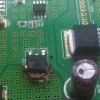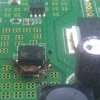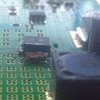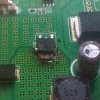Hello again,
So recently I dug out a rather nice 1440p Qnix monitor that had gone kaput a while back and never got around to sending back to the manufacturer for a replacement. I decided to message the merchant, and they said that if I want to I can attempt to fix it myself, and in the event I cannot, they will provide me with a replacement (so long as I ship the old one back) even though the monitor is long past warranty (I bought it in 2013) so win-win right?
Problem is, I cannot identify the n-mosfet on the board. I found another fellow on another forum who had asked a similar question, but given that he only has two posts and hasn't had any activity on the forum since November I am doubtful I will here back from him.
I am hoping somebody here can point me in the direction of a suitable replacement part, as it should be a relatively easy fix (assuming it is only the visible damage I have to worry about). The part is marked as 540N 3811G.
The provided picture is taken from the other thread as mine is the exact same board, same part, same place, same damage.
Thanks again people, very helpful community here and I really appreciate all of the help I can get.
So recently I dug out a rather nice 1440p Qnix monitor that had gone kaput a while back and never got around to sending back to the manufacturer for a replacement. I decided to message the merchant, and they said that if I want to I can attempt to fix it myself, and in the event I cannot, they will provide me with a replacement (so long as I ship the old one back) even though the monitor is long past warranty (I bought it in 2013) so win-win right?
Problem is, I cannot identify the n-mosfet on the board. I found another fellow on another forum who had asked a similar question, but given that he only has two posts and hasn't had any activity on the forum since November I am doubtful I will here back from him.
I am hoping somebody here can point me in the direction of a suitable replacement part, as it should be a relatively easy fix (assuming it is only the visible damage I have to worry about). The part is marked as 540N 3811G.
The provided picture is taken from the other thread as mine is the exact same board, same part, same place, same damage.
Thanks again people, very helpful community here and I really appreciate all of the help I can get.






